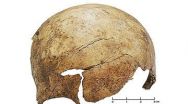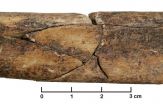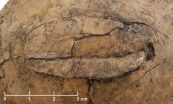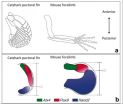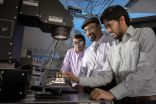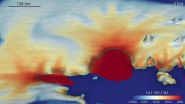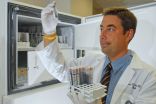Massacres, torture and mutilation: Extreme violence in neolithic conflicts
2015-08-18
(Press-News.org) Violent conflicts in Neolithic Europe were held more brutally than has been known so far. This emerges from a recent anthropological analysis of the roughly 7000-year-old mass grave of Schöneck-Kilianstädten by researcher of the Universities of Basel and Mainz. The findings, published in the journal PNAS, show that victims were murdered and deliberately mutilated.
It was during the time when Europeans first began to farm. To what degree conflicts and wars featured in the early Neolithic (5600 to 4900 B.C.), and especially in the so-called Linear Pottery culture (in German, Linearbandkeramik, LBK), is a disputed theme in research. It is particularly unclear whether social tensions were responsible for the termination of this era. So far two mass graves from this period were known to stem from armed conflicts (Talheim, Germany, and Asparn/Schletz, Austria).
Researcher from the Universities of Basel and Mainz now report new findings after analyzing the human remains of the mass grave of Schöneck-Kilianstädten (Germany), a massacre site discovered in 2006. Their results show that the prehistoric attackers used unprecedented violence against their victims. The researchers examined and analyzed the bones and skeletons of at least 26, mainly male, adults and children - most of them exhibiting severe injuries.
Torture and mutilation
Besides various types of (bone) injuries caused by arrows, they also found many cases of massive damage to the head, face and teeth, some inflicted on the victims shorty before or after their death. In addition, the attackers systematically broke their victims' legs, pointing to torture and deliberate mutilation. Only few female remains were found, which further indicates that women were not actively involved in the fighting and that they were possibly abducted by the attackers.
The authors of the study thus presume that such massacres were not isolated occurrences but represented frequent features of the early Central European Neolithic period. The fact that the Neolithic massacre sites examined so far are all located in some distance to each other further underlines this conclusion. The researchers thus suggest that the goal of this massive and systematic violence may have been the annihilation of entire communities. The research team was led by Prof. Kurt W. Alt, former Head of the Institute of Anthropology at the University of Mainz and guest lecturer at the University of Basel since 2014.
INFORMATION:
Original source
Christian Meyer, Christian Lohr, Detlef Gronenborn, and Kurt W. Alt
The massacre mass grave of Schöneck-Kilianstädten reveals new insights into collective violence in Early Neolithic Central Europe
PNAS Early Edition .....
http://www.pnas.org/cgi/doi/10.1073/pnas.1504365112
ELSE PRESS RELEASES FROM THIS DATE:
2015-08-18
A study of catsharks reveals how alterations in the expression and function of certain genes in limb buds underlie the evolution of fish fins to limbs. The findings are reported by researchers from Tokyo Institute of Technology (Tokyo Tech), the Centre for Genomic Regulation (CRG, Barcelona) and their collaborators in the journal eLife and give new insight into how fish evolved to live on land in the form of early tetrapods.
The first four-legged, land-living creatures - known as early tetrapods - evolved from fish, following the transformation of fins into limbs. This ...
2015-08-18
Patient satisfaction is a very poor proxy for quality of care comparisons in elective cranial neurosurgery. Because deaths are rare events in elective cranial neurosurgery, reporting of surgeon or even department-specific mortality figures cannot differentiate a high or low level of the quality of care.
The current focus on patient safety in health care has led to public quality-of-care comparisons between health care facilities and even between individual health care professionals. In the United States, a new reimbursement method based on patient satisfaction ratings ...
2015-08-18
WEST LAFAYETTE, Ind. - New research findings contradict a fundamental assumption about the functioning of "organic" solar cells made of low-cost plastics, suggesting a new strategy for creating inexpensive solar technology.
Commercialization of organic solar cells has been hindered by inefficiencies, but the findings point toward a potential path to create a new class of solar technology able to compete with standard silicon cells.
"These solar cells could provide a huge cost advantage over silicon," said Muhammad Ashraful Alam, Purdue University's Jai N. Gupta Professor ...
2015-08-18
A new international study is the first to use a high-resolution, large-scale computer model to estimate how much ice the West Antarctic Ice Sheet could lose over the next couple of centuries, and how much that could add to sea-level rise. The results paint a clearer picture of West Antarctica's future than was previously possible. The study is published today (18 August) in The Cryosphere, an open access journal of the European Geosciences Union (EGU).
"The IPCC's [Intergovernmental Panel on Climate Change] 4th and 5th Assessment Reports both note that the acceleration ...
2015-08-18
A group of clinicians and geochemists are working to develop a test for the most common form of primary liver cancer, HCC (Hepatocellular Carcinoma). HCC kills over 600,000 people worldwide every year. It usually develops from chronic liver disease such as hepatitis or cirrhosis, but there is no good biochemical test to indicate when the cancer develops, meaning that even for patients most at risk, it is nearly impossible to know when a cancer may develop until symptoms appear. Now a multi-national group of scientists are developing a new test for HCC, based on methods ...
2015-08-18
COLUMBUS, Ohio - Employees with a racially diverse group of friends outside of work may actually perform better at their jobs, a new study suggests.
Researchers found that workers who had more different-race friends in their personal lives than their co-workers also tended to have a more racially diverse network of friends on the job. This broader network was linked to employees who did more tasks beyond their job responsibilities and who, under certain circumstances, had more trust in their supervisors.
"Your friends outside of work actually have this connection to ...
2015-08-18
This news release is available in French. This news release is available in French. New research shows that teaching young adolescents practical cooking skills leads to positive changes for the entire family. In an article published today in Applied Physiology, Nutrition, and Metabolism, an NRC Research Press journal (a division of Canadian Science Publishing), researchers evaluated the Kinect-Ed presentation and found an increase in the frequency of family dinners after participation.
Kinect-Ed, a 90-minute motivational nutrition education presentation, was ...
2015-08-18
BOSTON, Aug. 18, 2015 -- Cranberries are often touted as a way to protect against urinary tract infections, but that may be just the beginning. Researchers fed cranberry extracts to mice with colon cancer and found that the tumors diminished in size and number. Identifying the therapeutic molecules in the tart fruit could lead to a better understanding of its anti-cancer potential, they say.
The team will describe their approach in one of more than 9,000 presentations at the 250th National Meeting & Exposition of the American Chemical Society (ACS), the world's largest ...
2015-08-18
BOSTON, Aug. 18, 2015 -- The use of solar energy in the U.S. is growing, but panels on rooftops are still a rare sight. They cost thousands of dollars, and homeowners don't recoup costs for years even in the sunniest or best-subsidized locales. But scientists may have a solution. They report today the development of a unique, "green" antenna that could potentially double the efficiencies of certain kinds of solar cells and make them more affordable.
The researchers are presenting their work at the 250th National Meeting & Exposition of the American Chemical Society (ACS). ...
2015-08-18
INDIANAPOLIS -- People being treated for bipolar disorder and other psychiatric illnesses are at greater risk of attempting suicide, but physicians may now have tools to predict which of those individuals will attempt it and intervene early to prevent such tragedies from occurring.
Researchers at Indiana University School of Medicine reported Tuesday in the Nature Publishing Group's leading journal in psychiatry, Molecular Psychiatry, that they have developed blood tests and questionnaire instruments that can predict with more than 90 percent accuracy which of those patients ...
LAST 30 PRESS RELEASES:
[Press-News.org] Massacres, torture and mutilation: Extreme violence in neolithic conflicts
